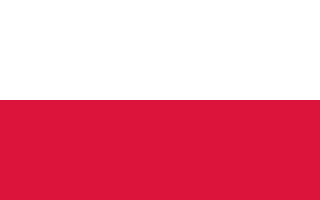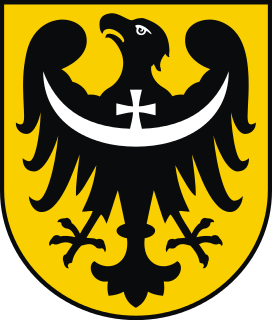
The national flag of Poland consists of two horizontal stripes of equal width, the upper one white and the lower one red. The two colours are defined in the Polish constitution as the national colours. A variant of the flag with the national coat of arms in the middle of the white fess is legally reserved for official use abroad and at sea. A similar flag with the addition of a white eagle is used as the naval ensign of Poland.

The coat of arms of the City of Wrocław is divided into quarters. It dates back to 1530, when it was approved by Emperor Charles V.

Sulima is a Polish coat of arms. It was used by several szlachta families in the Kingdom of Poland and the Polish–Lithuanian Commonwealth. Among its most notable users were Zawisza Czarny and the Sułkowski family.

Leliwa is a Polish coat of arms. It was used by several hundred szlachta families during the existence of the Kingdom of Poland and the Polish–Lithuanian Commonwealth, and remains in use today by many of the descendants of these families. There are several forms of the arms, all of which bear the name, Leliwa, but which may be distinguished as variations of the same arms by the addition of a Roman numeral. In 19th century during a pan South-Slavic Illyrian movement heraldic term Leliwa also entered Croatian heraldry as a name for the coat of arms considered to be the oldest known symbol; Bleu celeste, a mullet of six points Or surmounted above a crescent Argent – A golden six-pointed star over a silver crescent moon on a blue shield, but also as a name for all other coats of arms that have a crescent and a mullet.

Ciołek is a Polish coat of arms, one of the oldest in medieval Poland. It was used by many szlachta (noble) families under the late Piast dynasty, under the Polish–Lithuanian Commonwealth, during the Partitions of Poland, and in the 20th century. The variant names "Siolek" and "Cialek" arose from miscommunication among early-20th-century Polish immigrants to the United States.

Polish heraldry refers to the study of coats of arms in the lands of historical Poland. It focuses on specifically Polish traits of heraldry. The term is also used to refer to the Polish heraldic system, as opposed to systems used elsewhere, notably in Western Europe. As such, it is an integral part of the history of the szlachta, the nobility of Poland.

Brochwicz is a Polish coat of arms. It was used by several szlachta families.

The coat of arms of Egypt is known as the Republican Eagle or Egyptian Golden Eagle, is a heraldic golden eagle, facing the viewer's left (dexter). The eagle's breast is charged with an escutcheon bearing the red-white-black bands of the flag of Egypt rotated vertically, whilst the eagle's talons hold a scroll bearing the official name of the state written in Kufic script. The earliest version of the Eagle of Saladin was that used as the flag of Saladin, the first Sultan of Egypt, whilst the modern version of the eagle was adopted during the Egyptian Revolution of 1952. Subsequently, the modern design of the Eagle of Saladin was adopted as the coat of arms of numerous other states in the Arab World, namely the United Arab Republic, North Yemen, Iraq, South Yemen, the Libyan Arab Republic, and Palestine. The current eagle was modified in 1984 to its present form.

The eagle is used in heraldry as a charge, as a supporter, and as a crest. Heraldic eagles can be found throughout world history like in the Achaemenid Empire or in the present Republic of Indonesia. The European post-classical symbolism of the heraldic eagle is connected with the Roman Empire on one hand, and with Saint John the Evangelist on the other.

Alfred Znamierowski was a Polish vexillologist, heraldist, illustrator, and journalist. During his career he published several books and designed hundreds of coats of arms, flags, banners and seals for over 200 different municipalities and institutions.

The flag of the Duchy of Teschen was established in 2016 through the initiative of regional history enthusiasts in cooperation with the prominent Polish heraldic and vexillologist Alfred Znamierowski. The flag refers to the coat of arms and the historic banners of the Duchy of Teschen. The modern flag is an expression of respect for the history and tradition of the Duchy of Teschen, and also part of the different identities of the present inhabitants of the Cieszyn Silesia towards Lower and Upper Silesia.

The flag of the Lesser Poland Voivodeship, Poland is a tricolour rectangle, with three horizontal stripes: white, yellow, and red, with the top and bottom stripes being twice the size of the middle one.

The coat of arms of Lower Silesia, and simultaneously of Silesia, shows a black eagle with silver crescent with cross in the middle on its chest on a golden background. It has been assumed in the tradition that the coat of arms and colors of Lower Silesia are simultaneously used as symbols of Silesia as a whole.

The flag of Silesia and Lower Silesia is a bicolor of silver and gold.

The Flag of the Silesian Voivodeship is a bicolor of dark blue and gold.

The flag is the symbol of the city of Szczecin in West Pomeranian Voivodeship, Poland.

Szaszor, also known as Saszor, is a heraldic charge in the shape of headless eagle.

The flag of the Masovian Voivodeship, Poland is a red rectangle with silver (white) eagle, with golden (yellow) beak and legs, located on the left side of the flag.

The flag of the Lower Silesian Voivodeship, Poland, is a yellow (golden) rectangle with the left-faced black eagle, with a white (silver) crescent-shaped wingcloth put across its wings, with a white (silver) cross pattée on top of it, in its middle.






















